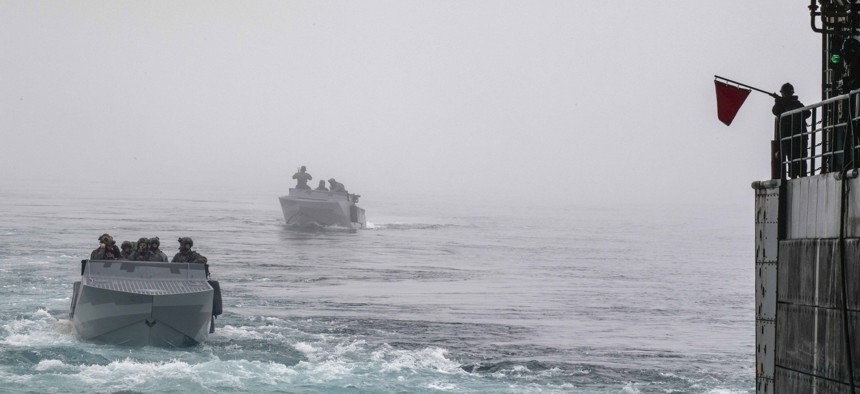
Two combatant crafts assault are launch from the well deck of amphibious transport dock ship USS John P. Murtha (LPD 26) during Operation POLAR DAGGER, Aug. 23, 2023. U.S. Navy / Mass Communication Specialist 2nd Class Joshua Samoluk
With eye toward Russia and China, NORTHCOM concludes special mission in the Arctic
“It's really both competitors we see operating up there, routinely,” commander says.
Last month, just days after four Russian military aircraft flew in Alaska Air Defense Identification Zone, teams of U.S. special operations forces conducted a mission on St. Lawrence island in the Bering Sea, just 50 miles away from continental Russia, as well as on Shemya Island, which sits in Alaska’s remote Aleutian island chain. The objective of what NORTHCOM is calling Operation Polar Dagger was to extend U.S capabilities to monitor the air and sea domain in the Arctic and showcase how well special operator air, land, and sea teams work together in harsh, long-distance environments like the Bering Sea.
“We have an airfield on Shemya Island that allows us to push our joint capability between our conventional U.S. Air Force and Navy partners and the special operations forces. to out to the farthest reaches of the NORTHCOM AOR. Pushing the forces out there allows us to demonstrate our operational reach in ways that are unique to anywhere in the homeland,” Special Operations Command Northern Command or SOCNORTH commander Col. Matthew Tucker told Defense One in an exclusive interview. St. Lawrence, meanwhile, “is set in the middle of key strategic terrain that sits astride the Bering Strait. It is in close proximity to one of our strategic competitors,” namely Russia.
This was the second iteration of Operation Polar Dagger and this year’s version of the operation was larger than last year’s, bringing in the John P. Murtha LPD 26 transport ship and an AC-130 plane in order to build out faster intelligence, communications and operations between the air, sea and ground. One of the chief goals of the operation was to show improved “domain awareness,” said Tucker, “to understand what's being seen in the air is effectively communicated to the forces on the ground. And then the opposite of that, that the forces on the ground are able to communicate their perception of domain awareness to the forces in the air … The second aspect would be our ability to deliver effects kinetic or nonkinetic, from air to ground, in support of the ground forces, or ultimately in supporting the mission of the air components.”
Tucker said that while SOCNORTH was assessing the operation and the ability to operate at such distances and under such conditions, Polar Dagger projected still presence in the Arctic. “In this operation we are competitor focused, demonstrating real-world operational reach to both defend critical infrastructure, enhance our all domain awareness, and better understand some of our competitor activity in the Arctic.”
Those competitors, Russia and China, have been increasing their own activity in the Arctic. That increased activity prompted the Pentagon to establish a new Arctic strategy and global resilience office in 2022, following the publication of a DOD Arctic Strategy in 2019.
“In different ways, Russia and China are challenging the rules-based order in the Arctic. Russia regulates maritime operations in the (Northern Sea Route), contrary to international law, and has reportedly threatened to use force against vessels that fail to abide by Russian regulations … China is attempting to gain a role in the Arctic in ways that may undermine international rules and norms, and there is a risk that its predatory economic behavior globally may be repeated in the Arctic,” that strategy reads.
Russia and China have been coordinating more in the Arctic as well, said Tucker. “Both of our strategic competitors are increasing their activity. Obviously, one strategic competitor maintains a tremendous amount of shoreline up there and has some very direct economic interest. Another strategic competitor recently declared themselves a near Arctic nation, and they are working in conjunction with Russia to better understand the environment, the economic opportunities, and other positions of advantage they might be able to seize by becoming more active in the Arctic. I would say it's really both competitors we see operating up there, routinely.”
